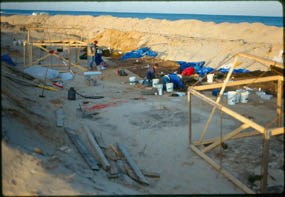
In November 1990, the Archeology Branch of the Cultural Resources Center (CRC), National Park Service (NPS) was contacted to assess an eroding feature at Coast Guard Beach within the Cape Cod National Seashore. The feature was determined to be undisturbed and of Native origin. Additional exploratory excavation was recommended and revealed a deeply buried ground surface and the likelihood of additional significant deposits. Over the next 16 months, 5 episodes of fieldwork were conducted on portions of the Carns site exposing more than 300 square meters of site area. Two factors were responsible for converting an exploratory investigation into a full-scale data recovery. First was the active, ongoing threat to the site from erosion. During the course of the project, several severe storms did scour the area, removing a significant percentage of the site. The second factor was a belief that the Carns site contained cultural components of great antiquity. This premise was based on the recovery of artifact forms similar to those from the Early and Middle Archaic periods. Broader consultation early in the process, especially with the Massachusetts SHPO and professional colleagues outside the NPS, would have provided other interpretations. Preliminary analysis of the excavation data confirms that the Carns site did contain significant archeological resources and that these features and artifacts date primarily from the end of the Early Woodland Period through the Middle Woodland Period, or approximately 2,100 to 1,100 years ago. This period is poorly understood and the Carns site represents an important contribution to our knowledge of Cape Cod’s history. No evidence of earlier occupations was found. 
NPS Image An additional consequence of the greatly expanded fieldwork was the creation of a very large laboratory component. To date, all the artifacts from the site have been catalogued and most have received at least a preliminary level of analysis. However, after ten years, more than 200 boxes of feature fill and soil samples have yet to be processed. Much of the processed material remains to be analyzed. Based on the results obtained from the limited analysis done to date, significant information most likely remains buried away in these samples. The Carns site has several lessons to teach, given the project’s extent and high level of public visibility. This report summarizes what has been learned so far through excavation and initial analysis. Recommendations are also made for the ongoing issues of collections management and site management as well as public education and interpretation. Excerpt from Management Summary, Archeological Investigations at the Carns Site report JAMES W. BRADLEY, Ph.D., is the founder and president of ArchLink, an independent, individually owned business Linking Archeology with Education and Preservation. He received his Ph.D. from the Maxwell School at Syracuse University in 1979. Dr. Bradley served on the staff of the Massachusetts Historical Commission from 1979 to 1990 and was director of the Robert S. Peabody Museum of Archeology in Andover, MA from 1990 to 2001. |
Last updated: March 17, 2025
